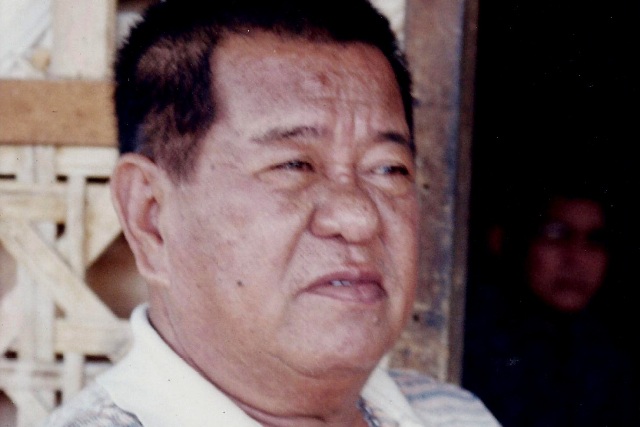Mindanao in 2015: Two events go down in history
COTABATO CITY, Philippines — Southerners will remember two events in 2015 that added colors to the rosy history of the Mindanao region.
These events are the now infamous Jan. 25, 2015 "Mamasapano incident" and the demise six months later of Datu Andal Ampatuan Sr., principal suspect in the Nov. 23, 2009 Maguindanao massacre, which left 58 people dead, 32 of them journalists.
The deadly encounter in Mamasapano town in Maguindanap occurred between operatives of the police's elite Special Action Force (SAF), members of the Moro Islamic Liberation Front (MILF) and a third group, the Bangsamoro Islamic Freedom Fighters (BIFF).
At least 44 SAF commandos, 17 MILF members and five innocent civilians perished in the gunfights, which erupted at dawn on Jan. 25, 2015 and lasted until past noontime the same day.
Also to be remembered by Mindanao folks for a long time was the death earlier that day of Malaysian terrorists Zulkifli bin Hir, most known as Marwan, the subject of the police operation in three barangays in Mamasapano.
The SAF men who killed Marwan in a dawn raid were on their way out when they were attacked by MILF and BIFF gunmen, provoking running firefights that waned only when representatives of the Malaysian-led International Monitoring Team (IMT) arrived and intervened.
The IMT, comprised of military and police officers from Malaysia, Brunei, Indonesia, Libya and non-uniformed conflict resolution experts from Japan, Norway and the European Union, has been helping oversee the enforcement of the interim government-MILF ceasefire accord in flashpoint areas in Mindanao since late 2003.
Marwan's cohort, the ethnic Maguindanaon bomber Abdulbasit Usman, who had escaped as SAF commandos stormed their hideout in Pidsandawan area in Mamasapano, was killed about five months later in Guindulugan town in Maguindanao by MILF forces under Imam Wahid Tundok.
What is now touted as the "Mamasapano incident" challenged the 18-year peace overture between the MILF and Malacañang.
It also stymied the enactment into law of the Bangsamoro Basic Law (BBL), the enabling measure for the replacement of the Autonomous Region in Muslim Mindanao (ARMM) with a more politically empowered Bangsamoro government.
The creation of such outfit is embodied in the government-MILF final compact dubbed the Comprehensive Agreement on the Bangsamoro.
The Mamasapano incident, which is for the MILF a result of government's failure to coordinate the tactical operation meant to neutralize Marwan and Usman, gave the BIFF, an extremist group sympathetic to the Islamic State of Iraq and Syria, publicity mileage for its jihadist ideals.
Residents of Mamasapano, a poor town in southwest of Maguindanao, have both good and sad stories about the January 25, 2015 incident in their municipality.
The saddest of these stories is about the deaths of five civilians trapped in the SAF-MILF-BIFF crossfire, which also caused the displacement of some 3,000 peasant families residing in the surroundings of the scenes of the deadly encounters.
The lighter story is about how the incident, as a consequence, ushered in about P100 million worth of development packages for the municipality, courtesy ARMM officials led by Gov. Mujiv Hataman, a political protégé of President Benigno Aquino III.
The projects, funded out of ARMM's 2013, 2014 and 2015 infrastructure subsidies, were implemented by the Hataman administration to help Mamasapano folks rise from underdevelopment and hasten their recovery from the adverse impacts of the carnage.
Hataman, his public works secretary, Engineer Don Mustapha Loong, and the chief engineer for the second district of Maguindanao, James Mlok, have constructed school buildings, water supply facilities and a Bailey bridge connecting both banks of the Tukanalipao River in west of Mamasapano in recent months.
Ampatuan's life story

The late Datu Andal Ampatuan Sr., the principal suspect in the 2009 Maguindanao massacre.
After the Mamasapano incident came the death in July 2015 of the Ampatuan clan leader, who once ruled Maguindanao province with an iron fist and conveniently eliminated political rivals using his private militias.
Ampatuan had served as governor of Maguindanao for three consecutive terms prior to the Nov. 23, 2009 massacre, which led to the demise of his political principality, sustained with money, firearms and the blind loyalty of many of the 36 mayors in the province.
Ampatuan's life story was like a journey on a bumpy road to fief and fame, perpetuated with violence and state resources, which started in the Maguindanao provincial jail and ended in July 2015 in a hospital bed where he died while being prosecuted for the slaughter of 58 people in 2009.
It was in the early 1980s when a still lowly, politically insignificant Ampatuan first landed at the Maguindanao provincial penitentiary for killing a nephew, Datu Unsek, while inside a coffee shop in the town proper of Shariff Aguak.
He was eventually implicated in the murders of no fewer than a hundred people as years came by.
Ampatuan is gone, but his name will surely be etched in the history of the province as Maguindanao's most controversial contemporary leader, who had absolute intolerance for political opposition and for his deep-seated animosity with Moro secessionist forces in his political bailiwicks.
Afflicted with liver cirrhosis, Ampatuan, one of the alleged brains in the infamous Nov. 23, 2009 Maguindanao massacre, died at the National Kidney Transplant Institute (NKTI) in July this year, about a week after he slipped into a coma after a heart attack.
Among the 58 people that perished in the massacre were the wife of then Buluan Vice Mayor Esmael Mangudadatu, Genalyn, and more than 30 journalists.
The victims were in a convoy en route to the old provincial capitol in Shariff Aguak to file on Mangudadatu's behalf his candidacy for governor of Maguindanao during the May 13, 2010 local polls.
The convoy was allegedly commandeered by members of the Ampatuan private militia led by then Mayor Andal Ampatuan Jr. of Datu Unsay town, herded to a hill along a highway in Barangay Masalay in Ampatuan municipality, where passengers were killed mercilessly with assault rifles and K3 machine guns.
Ampatuan Jr. was the favorite son of Ampatuan, who was called "ama" by his children, relatives and family friends.
The Ampatuans were opposed to Mangudadatu's plan then to contest the candidacy of Ampatuan Jr. for governor of Maguindanao, as the older Ampatuan's political heir-apparent.
The last nail that shut the coffin of the political fief of Ampatuan was Mangudadatu's election as governor in 2010. Mangudadatu was reelected to a second term on May 13, 2013.
Ampatuan, an icon of political impunity, was buried in his residential compound in Shariff Aguak town a day after he died in a hospital in July.
- Latest
- Trending























